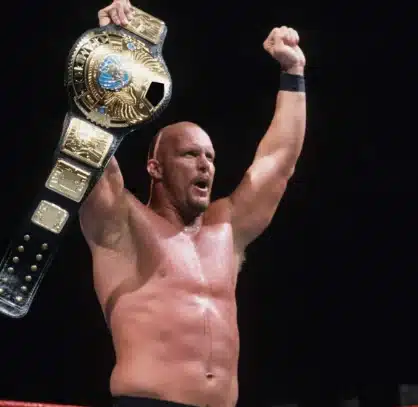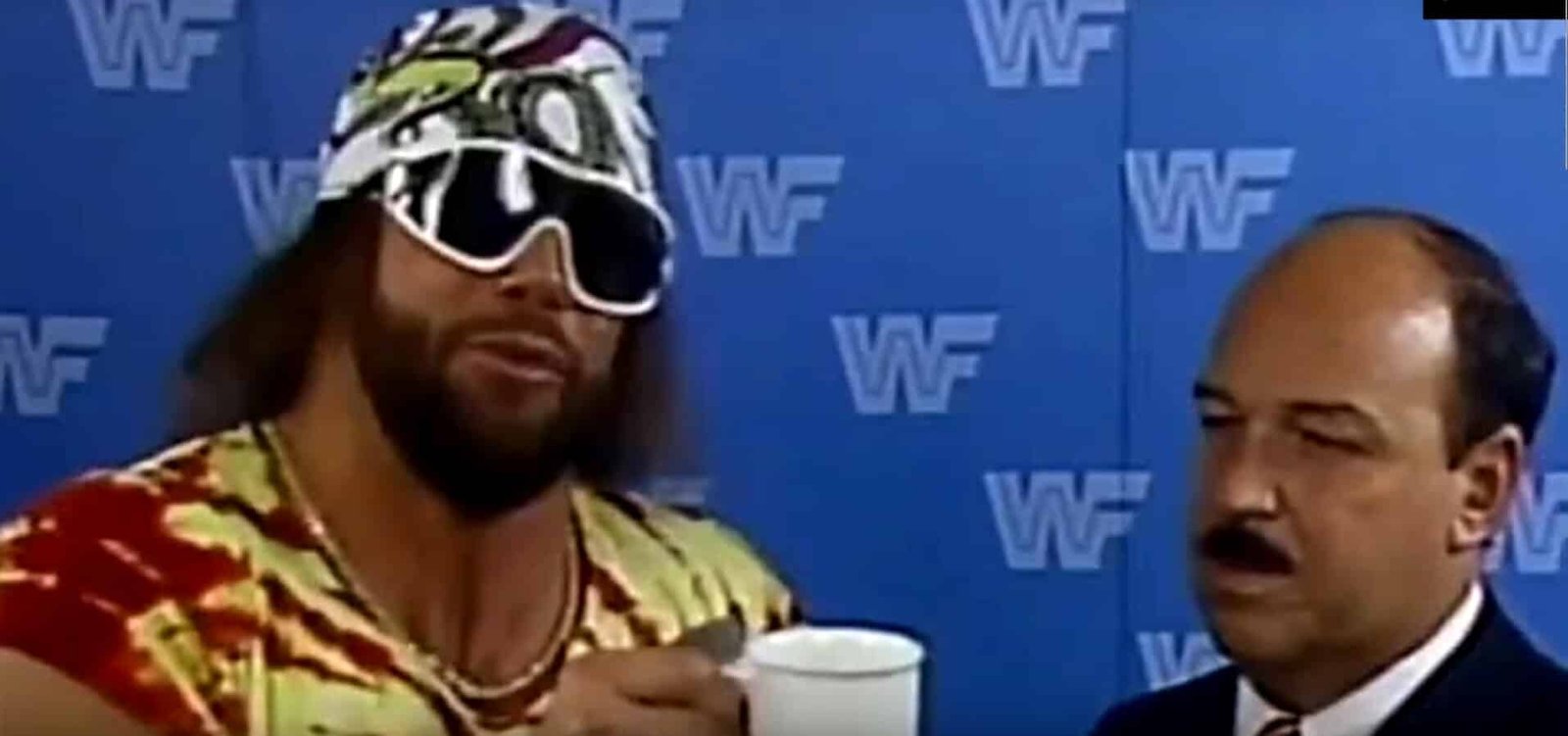“Cutting a promo” originates from professional wrestling‘s carnival era, when performers delivered dramatic monologues to “cut” through competing attractions and promote upcoming matches to paying audiences. The phrase describes wrestlers’ theatrical speeches that build character personas, establish storylines, and create emotional investment in rivalries. These promotional segments evolved from simple crowd-gathering tools into sophisticated entertainment vehicles that drive ticket sales and television ratings. Modern applications extend beyond wrestling into sports marketing and entertainment programming, where similar techniques generate audience engagement.

The Wrestling Ring Origins of “Cutting a Promo”
While modern audiences associate wrestling promos with polished television segments and scripted drama, the practice originated from a simple business necessity: wrestlers needed to sell tickets. Early promoters discovered that charismatic performers like Frank Gotch and Martin Burns could draw larger crowds through compelling public addresses.
These verbal segments emerged as entertainment between matches, keeping audiences invested in ongoing storylines and feuds. The term “cutting a promo” developed as wrestlers delivered live speeches in or near the ring to hype upcoming matches. Television significantly enhanced the character development opportunities that promos provided to wrestling performers.
Promoters recognized that dramatic speeches increased interest in rivalries, transforming athletic competition into narrative-driven entertainment. This verbal showmanship became essential for wrestlers seeking advancement, establishing promo skills as equally crucial to wrestling ability in determining promotional success and championship opportunities. A well-crafted promotional monologue serves as a powerful tool for wrestlers to connect with audiences and advance compelling narratives. Major wrestling organizations like the World Wide Wrestling Federation utilized these promotional techniques to build their stars and draw massive crowds to venues such as Madison Square Garden.
From Carny Culture to Television Entertainment
From traveling carnivals to prime-time television, professional wrestling’s promotional segments underwent a fundamental transformation that reshaped both the industry and American entertainment culture.
The promo’s carnival origins centered on impromptu showmanship designed to draw crowds to wrestling tents. Performers relied heavily on personal storytelling and improvisation, with minimal oversight from promoters. Local radio spots expanded this reach modestly during wrestling’s early regional era.
Television’s arrival in the 1950s and 1960s revolutionized promotional segments entirely. What once served purely local audiences suddenly reached millions nationwide through weekly broadcasts. This mass exposure transformed promos from simple crowd-gathering tools into sophisticated marketing vehicles that drove pay-per-view sales and merchandise revenue. The medium allowed wrestlers to perfect their scripted performances while maintaining the illusion of spontaneous conflict and rivalry.
The shift demanded greater production values and narrative consistency, fundamentally altering how wrestlers connected with audiences across America. Promoters began to recognize that promo skills often outweighed wrestling ability when evaluating talent for television success. Wrestling personalities learned to break the fourth wall during promotional segments, addressing real-life issues and management controversies to create more compelling narratives.
The Anatomy of an Effective Wrestling Promo
Breaking down the architecture of a compelling wrestling promo reveals five fundamental components that distinguish memorable segments from forgettable filler.
Message clarity establishes clear stakes by answering who, what, when, where, why, and how regarding upcoming conflicts. Wrestlers must maintain consistent messaging while avoiding off-topic rambling that dilutes narrative focus.
Emotional engagement drives audience investment through passionate delivery and varying vocal techniques. Authentic intensity transforms simple messages into memorable moments by incorporating personal stakes and challenges.
Body language reinforces verbal messaging through congruent facial expressions, gestures, and movement. Confident physicality signals character intent while signature poses strengthen brand recognition. These physical elements work together to establish a wrestler’s persona that audiences can instantly recognize and connect with.
Audience interaction creates immediacy through direct address, rhetorical questions, and references to shared storylines. Effective promos introduce narrative uncertainty to maintain engagement by keeping viewers questioning the story’s progression and outcome.
Finally, branding elements like catchphrases, distinctive vocal traits, and visual associations guarantee long-term memorability and cultural impact. Strong mic skills can even overshadow a wrestler’s in-ring performance and maintain their relevance throughout their career.

Building Characters Through Memorable Monologues
When wrestlers step up to the microphone, they transform from athletic performers into master storytellers whose words can forge careers and define legacies. Memorable monologues serve as the blueprint for character construction, allowing performers to establish unique voices through distinctive catchphrases and delivery styles.
Stone Cold’s “Austin 3:16” became a cultural phenomenon, while Road Dogg’s interactive opening lines created instant recognition.
These verbal showcases reveal character motivations and emotional depth. Paul Heyman’s grievance-filled speeches and The Miz’s recognition-seeking rants drive compelling story arcs by explaining their characters’ psychological makeup.
Personal vulnerabilities shared through promos humanize wrestlers, making them relatable beyond their in-ring personas. The most impactful moments often emerge when wrestlers confront real-life challenges, as emotional promos create deeper connections between performers and their audiences. The effectiveness of these monologues often varies between different eras and storytelling approaches, as wrestling evolves its presentation style.
Authentic emotion becomes the cornerstone of character mythology. John Cena’s passionate “never give up” speeches and Ric Flair’s emotional farewells create defining moments that transcend wrestling entertainment. These character-building moments extend beyond the microphone, as storytelling within matches continues to develop personalities through physical performance and in-ring psychology.
The Art of Trash Talk and Rivalry Development
While athleticism determines who wins matches, verbal warfare decides who commands attention and drives storylines that captivate audiences for months or even years. Effective trash talk operates on multiple psychological levels, destabilizing opponents through strategic insults, unexpected compliments that induce overthinking, and pointed questions that hijack focus.
These verbal exchanges transcend simple name-calling, becoming sophisticated tools for character development and narrative escalation. Creative insults fuel audience investment, generating emotional responses that translate into ticket sales and viewership. Wrestlers deploy various tactics—direct challenges to skill and legitimacy, sarcastic feigned respect, or references to past failures.
The timing and delivery amplify impact beyond mere words. Legendary rivalries are remembered equally for their verbal battles and physical confrontations, cementing legacies through iconic phrases that define careers and transform personal conflicts into business-defining events. The most compelling feuds often feature an antihero character who blurs the lines between hero and villain, creating complex dynamics that keep audiences emotionally invested. The evolution from newspaper interviews to modern platforms demonstrates how verbal combat has adapted to reach broader audiences. This practice serves as a powerful marketing tool that enhances the competitive narrative between opponents and raises the personal stakes of each encounter.
Script vs. Improvisation in Promo Delivery
The tension between scripted precision and spontaneous authenticity defines one of wrestling’s most critical creative battlegrounds. Major promotions like WWE rely heavily on detailed scripts, specifying key phrases and storyline elements to maintain narrative coherence and broadcast timing. This approach minimizes risk but often produces stilted delivery that fails to connect emotionally with audiences.
Conversely, improvised promos allow wrestlers to adapt to crowd reactions and create organic moments. Legendary performers like The Rock built careers using bullet-point outlines rather than word-for-word scripts, generating memorable catchphrases and viral interactions. This flexibility enables performers to respond to unexpected developments and enhance real-time audience engagement. The effectiveness of any promo ultimately depends on maintaining the foundational illusion that the conflict and emotions being expressed are genuine.
Modern wrestling increasingly favors hybrid approaches, providing structured frameworks while encouraging personalized delivery. Storylines are heavily scripted to integrate character themes into promotional segments and maintain overarching narrative consistency. This method balances creative freedom with storyline control, though veterans typically receive more improvisational latitude than newer talent.
Physical Performance and Theatrical Elements
A wrestler’s microphone becomes a spotlight that illuminates every gesture, expression, and physical choice before thousands of live spectators and television cameras. Physical performance transforms spoken words into compelling theater through controlled body language and strategic positioning.
Posture establishes immediate dominance or vulnerability. A wrestler’s stance—whether towering with arms spread wide or crouched defensively—communicates character alignment before any words are spoken. Facial expressions amplify narrative stakes through intensity, smirks, or calculated sneers that signal threat levels.
Movement within the performance space creates dramatic tension. Approaching opponents suggests aggression, while retreating indicates strategy or fear. Pacing and circling sustain audience attention during lengthy segments. Elite performers often incorporate aerial maneuvers during heated confrontations to punctuate their verbal declarations with spectacular physical demonstrations.
Successful promo delivery demands exceptional physical conditioning. High cardio capacity guarantees wrestlers maintain energy and vocal projection throughout intense performances, especially after physical confrontations or lengthy matches. Wrestling personalities understand that high energy throughout their segment prevents audience disengagement and maintains the dramatic momentum essential for effective storytelling.
Supreme-Inspired Wrestling T-shirt
Unleash your passion with our Supreme logo-inspired tee! Crafted for comfort and style, this 100% cotton t-shirt features a bold ‘wrestling’ design on a vibrant red background. Lightweight, pre-shrunk, and meticulously constructed, it’s the perfect blend of durability and softness. Elevate your wardrobe and showcase your love for wrestling with this standout tee. It’s ideal for every wrestling enthusiast!
Beyond Wrestling: Sports and Entertainment Applications
Athletes across professional sports utilize wrestling-style promotional tactics to build personal brands and secure lucrative endorsement deals. The entertainment sector has adopted episodic storytelling methods, with streaming platforms employing wrestling’s week-to-week audience retention strategies to maintain subscriber engagement.
Corporate executives increasingly embrace promo-inspired communication techniques during product launches and company presentations, recognizing the power of theatrical delivery in capturing attention. Wrestling’s influence extends to kayfabe principles, where maintaining character authenticity becomes essential for sustained audience engagement across various entertainment mediums. The detailed scripting processes used in wrestling shows have become blueprints for creating compelling narratives in other entertainment formats.
Social media influencers mirror wrestling personalities by creating compelling personas through direct audience engagement and behind-the-scenes content. Interactive digital features like polls and hashtags, originally popularized in wrestling promotion, now appear across entertainment platforms to boost viewer participation and drive advertising revenue. Wrestling programming consistently attracts large, engaged audiences that make it an increasingly valuable medium for advertisers seeking reliable viewership.
Creating Emotional Investment in Storylines
Wrestling’s greatest achievement lies not in athletic spectacle, but in its mastery of emotional manipulation through storytelling. Successful promotions understand that emotional investment drives audience loyalty more effectively than technical prowess alone.
Character development forms the foundation of compelling wrestling narratives. Wrestlers embody relatable struggles—overcoming adversity, seeking redemption, or confronting betrayal. These archetypal conflicts activate brain regions linked to memory and decision-making, creating lasting connections with viewers. Behind every compelling hero’s journey, there are enhancement talents who sacrifice their own victories to elevate the stars, playing an essential role in creating believable dominance.
Effective storylines incorporate suspense and genuine stakes. A championship belt represents more than gold; it symbolizes validation, legacy, and personal triumph. When audiences believe consequences matter, engagement metrics consistently show increased viewing time and emotional participation. Wrestling demonstrates that stories enhance data retention significantly, with audiences remembering character arcs and plot developments far better than isolated match results. The most compelling storylines feature emotional shifts as characters face obstacles and overcome challenges, creating dynamic responses that maintain viewer engagement throughout extended narratives.
Wrestling promotions that prioritize authentic character arcs over manufactured drama achieve higher retention rates. This emotional foundation transforms casual viewers into devoted fans who invest years following their preferred performers’ journeys.
The Legacy of Iconic Promos in Pop Culture
Beyond the confines of wrestling arenas, certain promotional segments have transcended their original medium to become defining moments in American entertainment history. Stone Cold Steve Austin’s “Austin 3:16” declaration became the top-selling wrestling merchandise of all time while infiltrating broader pop culture vocabulary.
CM Punk’s 2011 “Pipe Bomb” promo generated mainstream media coverage and shifted industry standards toward more authentic delivery. Hulk Hogan’s shocking heel turn received extensive press attention, symbolizing cultural shifts in heroism narratives.
The Rock’s catchphrases like “If ya smell what The Rock is cookin'” permeated sports and entertainment lexicon, facilitating his transition to Hollywood stardom.
Dusty Rhodes’ “Hard Times” promo continues being quoted in non-wrestling contexts as quintessential American storytelling. These segments demonstrated wrestling’s capacity to influence cultural discourse beyond its traditional audience. Roddy Piper’s groundbreaking “Piper’s Pit” segments inspired countless talk show formats that became staples of modern wrestling programming. Eddie Guerrero’s deeply personal addiction promo created emotional connections with audiences by addressing real-life struggles and themes of redemption.
Frequently Asked Questions
How Much Money Do Wrestlers Earn From Cutting Successful Promos?
Wrestlers rarely receive direct payment for individual promos, as compensation operates on salary or event-based structures.
However, successful promos generate substantial indirect income through merchandise sales—LA Knight earned approximately $1.9 million from promo-driven popularity, while Stone Cold’s iconic segments produced over $1 million in merchandise revenue.
Effective promo work elevates wrestlers to main event status, securing higher base salaries and lucrative contract renewals.
What Legal Issues Arise When Wrestlers Make Controversial Statements During Promos?
Controversial wrestling statements trigger multiple legal risks.
Defamation lawsuits arise when remarks damage reputations, even during storylines. Non-disparagement clauses in contracts prohibit negative company comments, with violations causing termination or legal action.
Intellectual property disputes emerge when wrestlers reference copyrighted characters without permission.
Broadcasting regulations demand compliance with decency standards, risking fines for hate speech or obscenity.
Independent contractor status leaves wrestlers individually liable for consequences.
Do Wrestlers Receive Formal Training in Public Speaking Before Cutting Promos?
Most professional wrestlers receive structured promo training at wrestling schools, where public speaking instruction holds equal importance to physical techniques.
Reputable academies incorporate formal promo workshops, character development exercises, and on-camera drills into their curriculum. Training covers vocal projection, body language, improvisation, and catchphrase development.
However, instruction quality varies notably between schools, with some emphasizing physical training over thorough speaking skills development.
How Do Language Barriers Affect International Wrestlers Cutting Promos in English?
Language barriers considerably hinder international wrestlers from cutting English promos.
Limited proficiency creates unclear messaging, weakening audience connection and character development. Mispronounced catchphrases lose impact, while grammatical errors generate unintended awkwardness. These challenges restrict storyline opportunities and television exposure.
However, promotions increasingly provide language coaching and collaborative writing support. Many wrestlers compensate through distinctive delivery styles, exaggerated gestures, and bilingual elements that transform linguistic limitations into unique character assets.
What Happens When Wrestlers Break Character or Make Mistakes During Live Promos?
When wrestlers break character or flub lines during live promos, the consequences vary dramatically. Breaking kayfabe can undermine storylines and damage credibility, while technical mistakes create uncomfortable moments that spread rapidly on social media.
Seasoned performers often recover through improvisation or humor, turning errors into memorable segments. However, persistent promo failures can derail pushes, limit future opportunities, and overshadow entire careers permanently.


